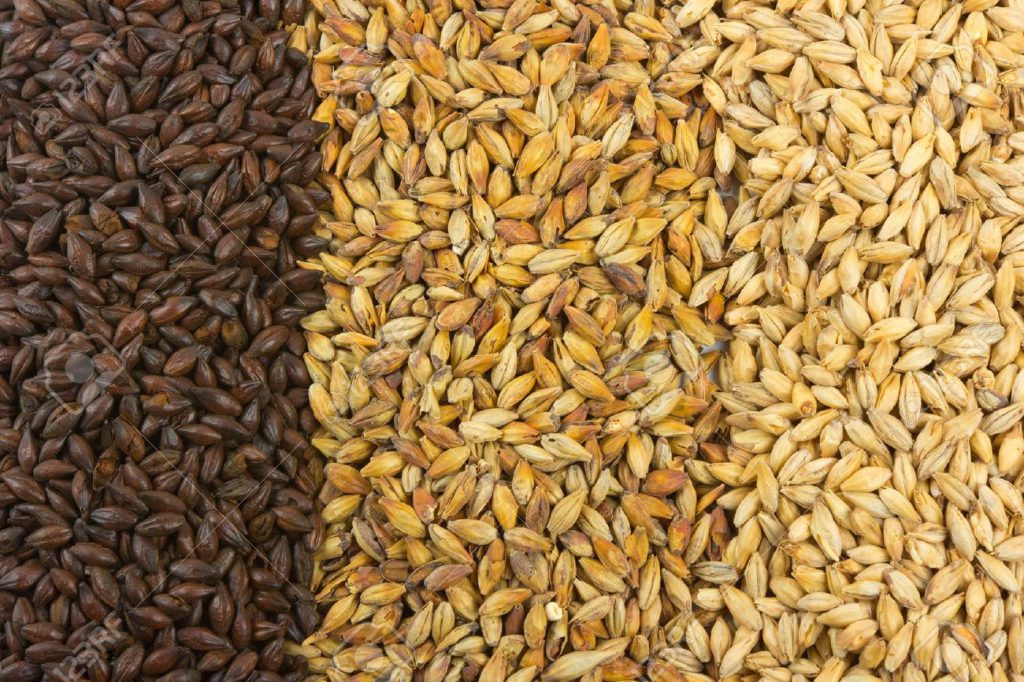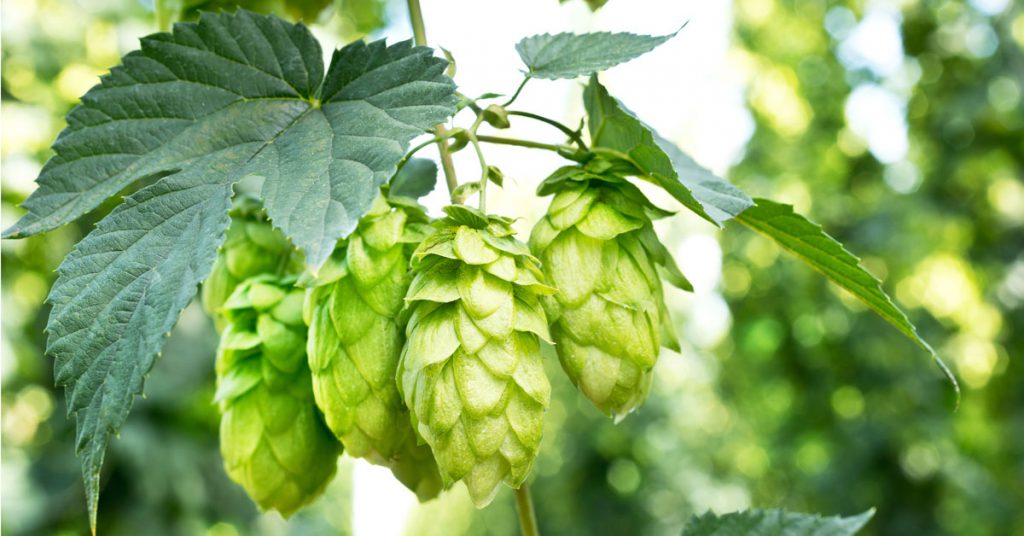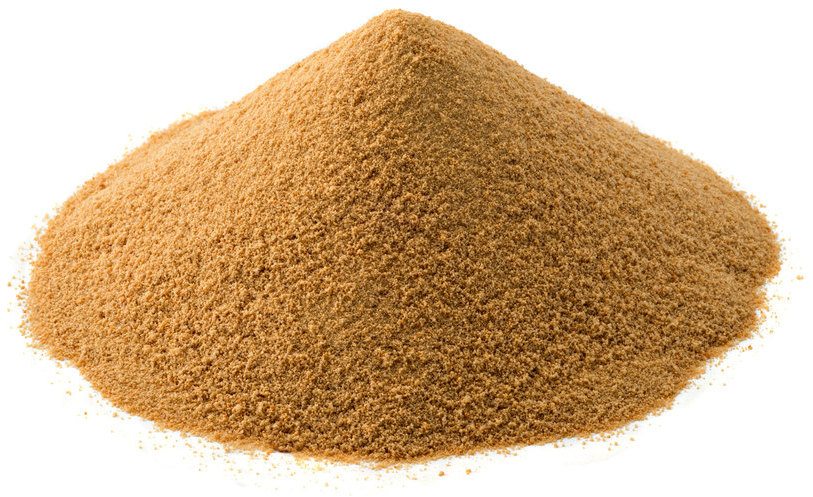Have you ever wondered about beer ingredients and what you’re drinking as that tasty beverage goes down? What is beer made of, anyway?
If you’re a craft beer lover or looking to brew your own beer you certainly need to know about the main beer ingredients. It’s insanely important to not just know the beer ingredients, but really understand what each ingredient does as you start your quest to brew beer at home.
Brewing beer is kind of like a science experiment, but the end result is something that tastes great. Each ingredient comes together at specific stages of the brewing process to, and after your brew ferments the end result is a beer that you’ll hopefully love.
What is beer made of? The Four Main Ingredients in Beer.
1. Water

By volume water is the largest beer ingredient. You probably knew this already. And it’s over 90% of a beer’s composition. In fact, it wasn’t too long ago that a major health benefit of beer was that it was boiled and safe for consumption. The water you use to brew your own beer is a very important factor since it makes up the majority of the beer ingredients. Since it’s the main ingredient it’ll have a big impact on how the final product turns out. Even if you did everything else correctly with your choice of ingredients if you don’t have good water your beer could end up tasting terrible. So the chemical makeup of your beer is important and can easily change which impacts the taste. If you ever accidentally froze your beer you might notice the different taste.
And don’t think that the worlds most abundant resource is the same no matter where you are in the world. It may even vary locally. The options you have to choose from are distilled, straight from the tap, purified drinking water, and possibly using rain water as a source if you collect that.
Home Brewing with Purified Drinking Water
If you want to take the easiest route and the safest option for your home brew than purified drinking water is the best option. Since it comes from a natural spring it has the necessary mineral content for a great home brew. You may want to contact bottled water companies and ask them for their analysis to determine which brand is right for you. One benefit is that purified water will generally be consistent in its chemical makeup since the source is usually always the same along with the purification process.
Home Brewing with Distilled Water
Before we get into what distilled water is let’s just say that it’s not a good option or recommended for brewing beer. When water is distilled it’s boiled and then condensed back into a liquid form. All impurities are removed during the distilling process. While removing the impurities may seem like a home run for quality beer it is not the case.
First of all, important minerals are taken out of which can have a negative effect on the taste of your beer. Some of the minerals that are removed are crucial for fermentation of the beer. So if the minerals are removed the yeast will not be able to ferment the sugars into alcohol.
Lastly, although we recommended that you don’t go the distilled route because of the effect on fermentation it can be used for the purpose of dilution. For example, distilled water can be used to balance out the components in hard tap water. However, it is best to stay away from distilled water all together.
Homebrewing with Tap Water
If you choose to use tap water as one of your beer ingredients you’ll need to research your area to find out more information about the source. Depending on your location and the source there could be a number of additives including chlorine and other disinfectants. These additives help make water potable, and it’s great for drinking but not great for your beer. As a result of these additives there may be an impact on the fermentation of your homemade beer. Because tap water can affect the fermentation process it can ultimately affect the taste of your beer.
With the ease of access to tap water you should research what’s actually in it. From an analysis you can decide if this is actually a good option or not. Your local water department can give you an updated analysis on mineral content from their last test.
Home Brewing with Rainwater
Rain water is great for your garden, but not a great choice for one of your beer ingredients. Even if the rain falls from the sky right into a rain barrel it still would not be a good idea. It’s filled with all kinds of contaminants. Rain drops pick up contaminants from the atmosphere like carbon monoxide from cars or even lead and other particles. If you collect water and it isn’t used frequently there’s also a risk of bugs and other contaminants inside that aren’t just gross but also bad for your beer. After all, rain helps to clean the atmosphere of pollutants. It’s best to keep rainwater out of your beer even if you purify it.
2. Malt Or Grain Or Both (Partial Mash)

When choosing your beer ingredients there are three main methods for brewing beer: extract, partial mash and all-grain. But first…
What Exactly Is Malt?
Malt is a general term used as an abbreviation for several things associated with maltose and malted barley. Brewer’s malt is not Malted Milk Balls, Malted Milk Shakes, or malt extract. In those cases, the malt ingredient refers to maltose which is a sugar. Malts that brewers typically talk about are the specific types of malted barley that are processed to yield a wide range of fermentable maltose sugars. These include Lager Malts, Pale Malts, Vienna Malts, Munich Malts, Toasted, Roasted and Chocolate Malts.
Malt also adds flavors, aromas, and body to your beer while also adding a little bit of sweetness. With that said, there’s also many different varieties of malt you can buy to give off different flavors and aromas to your beer.
Now We Need To Talk About Barley
Have you ever noticed that after you drink a couple of beers you tend to feel full? Well, you can thank barley for that because it’s a cereal grain. I know, your mind probably just wandered off and started thinking about Cheerios, Fruit Loos, and Captain Crunch. But it’s not like that at all.
Cereal grains are used naturally in most foods. But in beer the barley has to be processed into malt or malted barley before you can use it to make beer. Malted barley is the preferred grain for most brewers. Barley is malted by soaking it in water for a few days which which encourages the grain to germinate. This process produces all of the components necessary for fermentation.
Most brewers, even the microbreweries, don’t malt their own barley anymore. The process is done by a professional maltster. It’s a complex process because as the grains soak you don’t want the grain to sprout too much. Basically, you don’t want the grain to take root and start growing a new plant.
Brewing with Malt Extract
Malt is produced through the germination of barley (or other cereals) seeds. Brewing with malt extract, whether it’s liquid or dry, is a great starting point for most brewers selecting their beer ingredients. A brew day with malt extract can be done in as little as two to three hours. This is one reason why malt extract is a great solution for those who want to brew when limited time is a factor. Also, since there is not a large time investment if a brew does not go in plans there is not as much time wasted using extrect.
Malt extract is made by mashing grains using one of several processes to produce wort, a hot sweet sugary liquid. The wort is then concentrated into to a thick syrup which is concentrated by evaporation under heat. Afterwards, the wort is rapidly cooled for better taste and to reach fermentation temperatures.
Partial Mash Brewing
Through the steps in a partial mash, you can create a more complex malt profile and gain access to a wider palette of grains. This will help save a big investment in all-grain equipment. Partial mash is like a transitional step between malt extract and all-grain brewing. A small mash can be used to provide wort complexity and freshness, but use a can of extract to provide the bulk of the fermentables. When partial mashing, only a portion of the grains required for an all-grain beer are mashed while the bulk of the wort is made from malt extract. Typically, only the specialty grains plus a small amount of pale malt are actually mashed. Then the runnings of the mash are mixed with malt extract and boiled to produce the beer.
All-Grain Brewing
All-grain brewing differs from extract brewing mainly in the wort production stage. The extra processes involved in all-grain brewing allow for a whole range of ingredients to be used which are not utilized in malt extract brewing. Extract brewers rely on the maltster to convert and extract fermentables from the grain for them. All-grain and partial-mash brewers reclaim this process giving the brewer total control over the final product.
When brewing with malt extract the wort was made by dissolving the malt extract in water. Steeping some specialty grains may have also been done to add some additional flavors. As an all-grain brewer, you will make your wort from malted grains and water. You soak crushed, malted grains in hot water to change starches into sugars, and then drain away the resulting sugary liquid. This liquid is now your wort.
3. Hops

Out of all of the main beer ingredients hops is the least essential out of all of the ingredients. Technically, hops are not actually needed to brew beer. But without hops, beer made with only water, yeast, and malt will be sweet and dull. Throughout brewing history, brewers have added something extra—usually a plant part of some sort—to give their beer balance and depth.
Hops contain an essential oil with a very bitter flavor. This bitterness counters the sweetness, mentioned above, from the malt to create a more balanced beer. It also acts as a preservative. Generally, hops are added to the boil stage of brewing. Hops are added at this time because it takes a fairly long time (around an hour) to unleash the “alpha” acids that bitter and balance the sweetness of the malt. While the alpha acids in the hops are responsible for bittering the beer, the beta acids have been found to counteract the inevitable effects of bacterial spoilage. The delay of spoilage gives beer a longer shelf life.
Hops’ unmistakably pungent aromatics (sometimes described as spicy, herbal, floral, piney, and citrusy) are unique. However, prior to the common use of hops in the Middle Ages, bitter herbs and spices, like juniper berries were used. Beers with strong hop aroma and flavors are said to be hoppy.
4. Yeast – The Most Important of All Beer Ingredients

Where hops was the least important of all beer ingredients yeast is the most important of all the beer ingredients. Besides good ole’ H2O, anyway. When yeast is added to a sugar-rich solution it immediately begins to consume the sugars and create more yeast. From a brewer’s point of view the growth of yeast isn’t important, but the waste products of the yeast are crucial to a brewer. The byproducts that come from yeast are alcohol and carbon dioxide which gives beer its fizz. As the food supply runs down and alcohol levels rise, the environment becomes toxic to the yeast and the yeast starts to becomes dormant.
Different strains of yeast naturally occur in different areas of the world which contributes to the regional styles of beer. The sixty or more defined beer styles in the world can all be sorted by their yeast into two broad families: the ale family and the lager family.
- Beers in the ale family are produced by yeast strains that operate better at warmer temperatures. Ale yeasts produce extra flavors in addition to creating alcohol: fruity, spicy, or earthy flavors are not unusual.
- Beers in the lager family are fermented by yeast strains that operate better at cooler temperatures. The lager beers are the traditional beers of Germany, the Czech Republic and central Europe.
Keep Your Yeast Happy
Because of the temperature differences each yeast strain produces very different flavors and aromas. In turn, the yeast creates the different beer styles. Yeast, in combination with different fermentation processes, can also contribute fruitiness and other flavor characteristics to the beer. Brewmasters try to keep these flavors in check, depending on which beer style they’re brewing.
You also need to remember that yeast is something that’s alive and is a living creature. So to get yeast to do what you want it to do you need to make sure the yeast is in the proper environment to make all of these wonderful beers. Temperature matters and keep all of the light out!

Benefits Of Homebrew Kits And Starter Recipes
Homebrew Kits
There’s a lot to take in when you start homebrewing. There’s so much equipment and other supplies out there that it could make your head explode. From brew kettles to scales and wort chillers to electric brewing systems there’s a lot of tools out there that you can geek out on.
Luckily, there are starter kits out there that can get you up and brewing right away. There’s a lot of benefits to starting out with a homebrew starter kit. They’re not that expensive. For the most part they’re not that complicated. But one of the best things is that it’ll get you up and running, and as you use it you start figuring out what you need, what you don’t need, and the tools that you want to upgrade.
Another nice thing about starter kits is that different kits come with different supplies. If you’re easily overwhelmed it could make the decision process a little more difficult. But the core supplies to brew come in almost all of them. However, some come with additional supplies like wort chillers, brew kettles, or a slightly higher end fermenter.
Homebrew Starter Recipe Kits
Have you ever had a home cooked meal that tasted so good and fresh that you wanted to get a recipe and make it on your own? But then you look at the recipe and think to yourself “But I’m not a world class chef who could make this.” and you never get to the point of making that awesome dish. However, there are some ways to make that awesome dish a little easier to make.
For example, instead of making seasoning for your tacos you buy a seasoning packet. Or you make homemade pasta sauce but you buy canned tomato sauce or diced tomatoes instead of milling tomatoes from scratch. Well, homebrewing beer works a similar way where you can find recipes to make it a little easier on you.
There’s a lot of kits out there for all kinds of different beers. Lagers, Ales, IPA’s, Stouts, Porters…there will be kits out there for you to make brewing any of these beers a little bit easier and still have a ton of good flavor in them.
Final Thoughts On Beer Ingredients And Starter Kits
We have answered the question of “what is beer made of” when brewing at home. Hopefully, you now have a better understanding of beer ingredients to become a better brewer and create a good beer with lots of flavor. Each of these beer ingredients has a critical impact to your final beer product, and slight changes can impact your brew.
As you brew, it might be worth your time to keep notes as you adjust recipes and make corrections. By doing this you can also correct any mistakes in the process of brewing. If you’re new to brewing it’s helpful to start out with one of these homebrew kits for your gear and supplies or the recipe kits to cut down on your guesswork for ingredients.
Happy brewing and hopefully you’ll be making all different kinds of wonderful beers.

